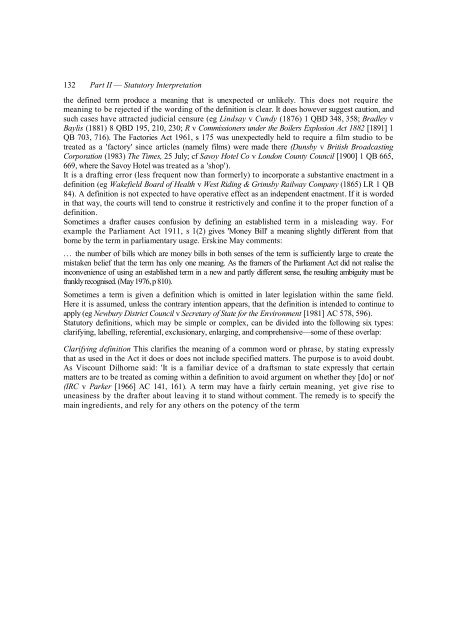Statutory Interpretation The Technique of Statutory ... - Francis Bennion
Statutory Interpretation The Technique of Statutory ... - Francis Bennion
Statutory Interpretation The Technique of Statutory ... - Francis Bennion
You also want an ePaper? Increase the reach of your titles
YUMPU automatically turns print PDFs into web optimized ePapers that Google loves.
132 Part II — <strong>Statutory</strong> <strong>Interpretation</strong><br />
the defined term produce a meaning that is unexpected or unlikely. This does not require the<br />
meaning to be rejected if the wording <strong>of</strong> the definition is clear. It does however suggest caution, and<br />
such cases have attracted judicial censure (eg Lindsay v Cundy (1876) 1 QBD 348, 358; Bradley v<br />
Baylis (1881) 8 QBD 195, 210, 230; R v Commissioners under the Boilers Explosion Act 1882 [1891] 1<br />
QB 703, 716). <strong>The</strong> Factories Act 1961, s 175 was unexpectedly held to require a film studio to be<br />
treated as a 'factory' since articles (namely films) were made there (Dunsby v British Broadcasting<br />
Corporation (1983) <strong>The</strong> Times, 25 July; cf Savoy Hotel Co v London County Council [1900] 1 QB 665,<br />
669, where the Savoy Hotel was treated as a 'shop').<br />
It is a drafting error (less frequent now than formerly) to incorporate a substantive enactment in a<br />
definition (eg Wakefield Board <strong>of</strong> Health v West Riding & Grimsby Railway Company (1865) LR 1 QB<br />
84). A definition is not expected to have operative effect as an independent enactment. If it is worded<br />
in that way, the courts will tend to construe it restrictively and confine it to the proper function <strong>of</strong> a<br />
definition.<br />
Sometimes a drafter causes confusion by defining an established term in a misleading way. For<br />
example the Parliament Act 1911, s 1(2) gives 'Money Bill' a meaning slightly different from that<br />
borne by the term in parliamentary usage. Erskine May comments:<br />
... the number <strong>of</strong> bills which are money bills in both senses <strong>of</strong> the term is sufficiently large to create the<br />
mistaken belief that the term has only one meaning. As the framers <strong>of</strong> the Parliament Act did not realise the<br />
inconvenience <strong>of</strong> using an established term in a new and partly different sense, the resulting ambiguity must be<br />
frankly recognised. (May 1976, p 810).<br />
Sometimes a term is given a definition which is omitted in later legislation within the same field.<br />
Here it is assumed, unless the contrary intention appears, that the definition is intended to continue to<br />
apply (eg Newbury District Council v Secretary <strong>of</strong> State for the Environment [1981] AC 578, 596).<br />
<strong>Statutory</strong> definitions, which may be simple or complex, can be divided into the following six types:<br />
clarifying, labelling, referential, exclusionary, enlarging, and comprehensive—some <strong>of</strong> these overlap:<br />
Clarifying definition This clarifies the meaning <strong>of</strong> a common word or phrase, by stating expressly<br />
that as used in the Act it does or does not include specified matters. <strong>The</strong> purpose is to avoid doubt.<br />
As Viscount Dilhorne said: 'It is a familiar device <strong>of</strong> a draftsman to state expressly that certain<br />
matters are to be treated as coming within a definition to avoid argument on whether they [do] or not'<br />
(IRC v Parker [1966] AC 141, 161). A term may have a fairly certain meaning, yet give rise to<br />
uneasiness by the drafter about leaving it to stand without comment. <strong>The</strong> remedy is to specify the<br />
main ingredients, and rely for any others on the potency <strong>of</strong> the term

















